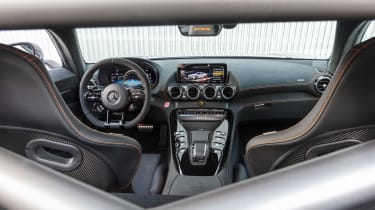Mercedes-AMG GT Black Series takes Nurburgring lap record
The 720bhp AMG GT Black Series is officially the world’s fastest production car around the ‘Ring with a lap time of 6:43.616 minutes
The £335,000 Mercedes-AMG GT Black Series has claimed the Nurburgring production car lap record. Affalterbach’s most extreme coupe recently set a time of 6:43.616 minutes, beating the previous record holder – the Lamborghini Aventador SVJ – by more than a second.
Mercedes says the record-setting AMG GT Black Series was only fitted with components that are available from the factory. However, in an effort to give the car an edge over the Aventador, the German firm’s engineers made the most of the GT’s adjustable chassis and aerodynamic settings to optimise the car for the Green Hell.
The standard AMG GT Black Series leaves the factory with manually adjustable suspension and manually adjustable aero. So, Mercedes set the anti-roll bars to their stiffest setting and cranked the camber up to the maximum (3.8 degrees up front and 3.0 degrees at the rear) to keep the car’s tyres in contact with the undulating surface of the track.
Mercedes also set the GT’s adjustable front splitter to its most aggressive setting which, combined with a middling angle for the rear wing, promoted sharper turn-in response – important on a track littered with 170 corners. The added benefit of running a little less downforce at the rear was a significant reduction in aerodynamic drag, which can compromise a car’s top speed.
Besides, Mercedes tells us that the AMG GT Black Series’s active aerodynamics made up for the less aggressive setting at the rear. There’s a moveable flap in the spoiler which automatically pops up under hard cornering and heavy braking, helping to stabilise the car.
For a bit of added safety, the car was also fitted with Mercedes’s Track Pack, which adds a pair of carbon-fibre backed bucket seats, four-point safety harnesses and a roll-cage – which has the added benefit of taking some of the flex out of the AMG GT’s chassis. However, even with the added weight of the roll cage, the Black Series still weighs around 35kg less than the AMG GT R Pro – mostly thanks to Mercedes’s liberal application of carbon fibre.
Finally, Mercedes opted for the softer compound of the two Michelin Pilot Sport Cup 2 R MO tyres available to GT R Black customers. In contrast to the harder of the two sets of tyres, these are designed to sacrifice durability to provide the ultimate level of grip.
GT3 racer and Nurburgring 24 Hour winner Marco Engel piloted the Black Series for its record breaking run. Afterwards, he commented: “That was a really impressive ride. With speeds of up to almost 270 km/h in the Kesselchen section of the track or well over 300 km/h on the long Döttinger Höhe straight, the AMG GT Black Series is significantly faster than my GT3 race car.”
Mercedes-AMG GT Black Series: engine and drivetrain
The GT Black Series is powered by a heavily modified version of the standard car’s twin-turbocharged 4.0-litre V8 engine, which has been fitted with a host of go-faster bits pinched from Mercedes’s GT GT3 racer.
Upgrades include a set of reprofiled camshafts, new exhaust manifolds, bigger turbos, larger intercoolers and an aggressive tune for the car’s ECU. The upgrade package is finished off with a larger-bore, thin-wall stainless steel exhaust system.
All these revisions mean the engine now produces 720bhp and 800Nm of torque – which is 250bhp and 200Nm more than the entry-level AMG GT. Power goes to the rear wheels via a beefed-up version of the car’s seven-speed automatic gearbox, which AMG says gives this latest Black Series model a 0–62mph time of 3.2 seconds and a top speed of 201mph.
Mercedes-AMG GT Black Series: chassis and brakes
Mercedes-AMG says the GT Black Series’s new engine is the most powerful V8 unit that has ever fitted to one of its cars – so, to keep all that performance in check, the firm has given the GT’s chassis a thorough overhaul with tougher, yet lighter, components.
There’s a new coil-over suspension system, which features electronically controlled dampers and double wishbone arms front and rear. The car’s suspension geometry has also been tweaked, allowing the GT Black Series to run more negative camber on the front axle – which Mercedes-AMG says will deliver improved cornering performance.
The GT Black Series also has a wider track than the standard model and, wherever possible, Mercedes has swapped metal components in the car’s chassis for carbon fibre replacement. So, there’s lightened versions of the GT’s front and rear torsion bars, as well as a new carbon fibre shear panel at the rear of the vehicle.
Mercedes has improved the GT’s brakes, too, with a larger set of drilled and vented ceramic discs with six-piston calipers up front and four-piston calipers at the rear – both of which are finished in black. The chassis is helped along by a new, configurable traction control system which features the same nine-stage slip control settings as the firm’s GT3 racer.
Mercedes-AMG GT Black Series: styling and aerodynamics
The AMG GT’s aerodynamics have been given an equally extensive update, with a similar range of tweaks as the firm’s GT3 racecar. Up front, there’s a new braced front splitter and reprofiled front bumper, which works with the new vented bonnet to improve the car’s downforce and expel excess heat from the engine bay.
Further upgrades include new vents for the front and rear wheel arches, allowing turbulent air which would normally be trapped in the wheel arches to escape. At the rear, there’s an aggressive diffuser and an enormous, manually adjustable rear wing, which can be tweaked through 20 degrees, offering either increased downforce or a reduced drag.
There’s also a new, near-full-length undertray, which the firm says will channel air towards the rear diffuser. In total, Mercedes-AMG says its aero tweaks produce a maximum of 400kg of downforce.
Finally, to lower the GT Black Series’s kerb weight and improve its centre of gravity, Mercedes-AMG has fitted a new carbon fibre roof, a carbon fibre boot lid and thinner glazing. The car’s hub carriers are also made from aluminium and there’s a new carbon fibre torque tube connecting the engine and the rear-mounted transmission.
Hungry for more impressive track times? Read our run-down of the fastest cars ever to lap the Nurburgring…
Find a car with the experts










